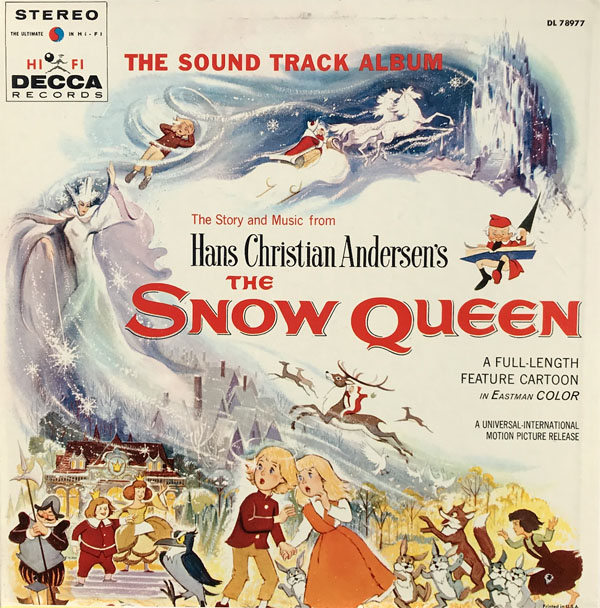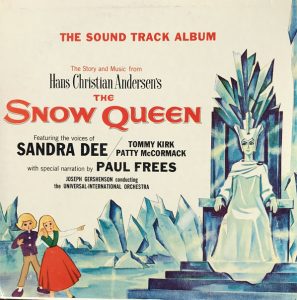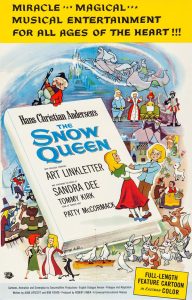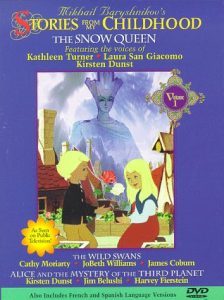A winter sound trek with the animated feature that inspired Miyazaki, captivated the Cannes Film Festival and became a Decca album with the voice of Gidget.

The Story and Music from
Hans Christian Andersen’s
THE SNOW QUEEN
The Sound Track Album
Decca DL-78977 (Stereo) / DL-8977 (Mono)
Released in 1959. Adapted from the 1957 Russian version written by Nikolai Erdman, Lev Atamanov, Georgly Grebner, and Nikolay Zabalotsky; produced by Lev Atamanov and Nickolay Petrovich Fydorov and Directed by Lev Atamanov for Soyuzmultfilm Studio. English screenplay: Alan Lipscott, Bob Fisher, Dialogue Supervisor/Editor: Hugo Grimaldi. Songs: Diane Lampert. Richard Loring. Music: Frank Skinner. Music Supervisor: Joseph Gershenson. English Dialogue Version Producer: Robert Faber. Technical Supervisor: Dave Fleischer. Sound Track Album Running Time: 40 minutes.
Voices: Paul Frees (Old Dreamy/Narrator, Bucky); Sandra Dee (Gerda); Tommy Kirk (Kay); Lillian Buyeff (Granny); Patty McCormick (Angel); Louise Arthur (Snow Queen); June Foray (Finnish Woman). (The voice of the Lapland woman who writes on the fish remains to be confirmed.)
Songs: “The Snow Queen,” and “Do It While You’re Young,” by Diane Lampert and Richard Loring. Instrumental: “The Jolly Robbers” by Richard Loring.
 In the late 1950s, feature animation was becoming so expensive that Sleeping Beauty was somewhat of a risk for Walt Disney. Nor was 1001 Arabian Nights a sure thing for UPA, even with the popular Mister Magoo in his first feature. Both underperformed in their initial releases. All the film studios were looking for ways to capture the family audiences that were getting used to staying home with their TV. Since WWII, Disney had only released a handful of new “single-story” animated features but was doing well with reissues of earlier titles.
In the late 1950s, feature animation was becoming so expensive that Sleeping Beauty was somewhat of a risk for Walt Disney. Nor was 1001 Arabian Nights a sure thing for UPA, even with the popular Mister Magoo in his first feature. Both underperformed in their initial releases. All the film studios were looking for ways to capture the family audiences that were getting used to staying home with their TV. Since WWII, Disney had only released a handful of new “single-story” animated features but was doing well with reissues of earlier titles.
Universal-International surely had high hopes for The Snow Queen in 1959, a film that had already won several major international awards, including one for animation at the Cannes Film Festival and the Golden Lion at the Venice Film Festival. The film took over two years to produce, using some of the classic Disney techniques including personality animation using live models and some rotoscoping. Universal managed to gain approval from both Walt Disney and Samuel Goldwyn for the release, as they both had plans to adapt the Hans Christian Andersen story for a film (decades before Frozen began to thaw).
The Snow Queen was also a Russian film, directed by Lev Atamanov and produced by Soyuzmultfilm, one of the world’s most prestigious studios (Roy E. Disney visited many years later and was presented with this film created to honor Mickey Mouse.) Releasing it during the height of the Cold War gave the film a transcendent place in world history. (There is a lot more detail about this, the production, and various influences, on this Wikipedia page.)
This is the original Russian language version:
Perhaps to give the United States version of The Snow Queen an all-American feel, Universal cast contract player and rising star Sandra Dee in the lead role as Gerda. By the time audiences Dee The Snow Queen, they had already become taken with her “Gidget” earlier the same year. Gerda, in her relentless, physically demanding search for Kay, was a precursor to modern-day animated females.
 A Disney touch was achieved with Tommy Kirk, who had impressed critics with his performance in Disney’s Old Yeller and consistently fine work on television, including TV’s first version of “The Hardy Boys” on the Mickey Mouse Club. Kirk appeared in several live-action Disney films, but never voiced a character in a Disney animated feature.
A Disney touch was achieved with Tommy Kirk, who had impressed critics with his performance in Disney’s Old Yeller and consistently fine work on television, including TV’s first version of “The Hardy Boys” on the Mickey Mouse Club. Kirk appeared in several live-action Disney films, but never voiced a character in a Disney animated feature.
To lengthen the film to what most audiences considered “feature-length,” and assure some cozy familiarity, a live-action prologue was filmed. TV personality Art Linkletter hosts a picture-perfect house at Christmastime, opening presents with children. At the time, Linkletter was a ubiquitous presence. Milton Bradley pictured him on the box and the play money for “The Game of Life.” For years, he hosted TV events and shows like House Party, which led to the best-selling “Kids Say the Darndest Things” book, illustrated by Charles M. Schulz.
In Universal’s Snow Queen prologue, several highly polished kids (including Billy Booth, “Tommy” of Screen Gems’ Dennis the Menace sitcom), trade quips with Linkletter, often adapted from the book. One of the children asks him to read a storybook. He suggests the movie we all are about to watch would be even better. They look into a magic mirror and the animation begins after the English titles.
The title song and two other tunes were written for the dubbed version by Diane Lampert and Richard Loring. The team’s credits include the song, “Biddle Dee Dee” for the Disney live-action feature, Toby Tyler, or Ten Weeks with the Circus. Lampert also wrote the lyrics (with Peter Farrow) and supervised the production of a very unique, now little-known 1963 musical made for records called Three Billion Millionaires. Created to bolster support for the United Nations and raise funds for UNICEF, the album was released in two versions. One was modestly produced by Golden Records featuring their stock company of studio performers, including Win Stracke and Rose Marie Jun (Jane on Golden’s Jetson album). The main release was heralded in The New York Times as “the first musical comedy created especially for records,” starring an impressive list of stars, all of whom volunteering their services.
The prologue was more effective when The Snow Queen ran on local TV stations during the Christmas season, especially in the years Linkletter was still familiar to most viewers, and somewhat nostalgic after he passed away. By adding the prologue, Universal narrowed the marketability of the English language version as holiday-only programming, though it certainly was shown at other times of the year.
This is one of the many public domain prints of 1959’s The Snow Queen including the prologue:
For the generations in the U.S. who watched this version yearly on TV, it was a welcome sight because such lush animation was usually reserved for the “event” of a Disney reissue or a clip here or there.
Decca Records decided to present the soundtrack as a story album rather than as a score with songs since there were only three. The stereo edition is especially rich, with the score by Frank Skinner (Harvey, My Man Godfrey, Abbott and Costello Meet Frankenstein) sounding magnificent in the background. The songs are given short shrift as two are incomplete and the third is only an instrumental. However, a large amount of the dialogue was included.
Gerda’s solo, “Do It While You’re Young,” sung as a dream montage when she is under the spell of the Enchantress, was released by Decca as a pop single with a different orchestra and arrangement. Note that the cover promotes the film.
 Atamanov’s The Snow Queen, in its original form and through various translations and versions seen worldwide, has had an immeasurable influence on the art form. According to nausicaa.net, “Miyazaki saw this film when he was unhappy about his job and wondering if he should continue working as an animator. Miyazaki was so moved by it, he ‘decided to continue working on an animation with renewed determination.’ He says that he learned that characters in animation can act if they are animated well enough, and animation can move people as other media can do.” Many see Princess Mononoke as inspired by The Snow Queen.
Atamanov’s The Snow Queen, in its original form and through various translations and versions seen worldwide, has had an immeasurable influence on the art form. According to nausicaa.net, “Miyazaki saw this film when he was unhappy about his job and wondering if he should continue working as an animator. Miyazaki was so moved by it, he ‘decided to continue working on an animation with renewed determination.’ He says that he learned that characters in animation can act if they are animated well enough, and animation can move people as other media can do.” Many see Princess Mononoke as inspired by The Snow Queen.
Another enthusiast is Mikhail Baryshnikov. In 1998, PBS presented a series of short and long Soyuzmultfilm tales with new soundtracks, star voices, and musical scores under the banner of Mikhail Baryshnikov’s Stories From My Childhood, featuring a collection.
The first episode was, not surprisingly, The Snow Queen. Mickey Rooney voices the storyteller, Kirsten Dunst is Gerda, and Kathleen Turner plays the Snow Queen. Songs from the series were released on CD, so there are, in effect, two English-language soundtrack albums with material inspired by Atamanov’s Snow Queen feature. The series was also released in volumes on DVD, which provided a way to see a good print of The Snow Queen in English, albeit not the 1959 version. These DVDs are long out of print, however.
At least the 1998 Baryshnikov remake was high quality. In 1993, the Atamanov feature was also redubbed in English, with a soundtrack replaced by a “sound-alike” with an electronic version of the Skinner background music and songs that did not fit the classic look of the film. The cassette appeared in bargain bins and could easily be confused with the 1959 public domain versions. Here’s a link to that: [Click Here].
An American DVD released through a company called By Jove includes the Russian language print as well as selected short animated stories by Lev Atamanov. It offers the best quality image of the feature other than Stories from My Childhood. Universal Home Entertainment has never produced an official release of the dubbed version with a restored image and soundtrack including the Linkletter prologue. At this point, the Decca album provides the best sound quality, but even that has a slight reverb.
“The Snow Queen” The Sound Track Album
Dubbing is an art unto itself and it is to the credit of this cast that they were able to master it as well as they did for this single film. Paul Frees was, of course, a master of the art. The album includes some of his narration in the character of Little Dreamy, with additional sections to bridge the edits. It’s interesting to compare the album portions with the soundtrack ones, the latter being more restricted to his need to match the mouth movements on the dubbing screen.
[A soupçon of earlier Animation Spin material was included in this article.]


 GREG EHRBAR is a freelance writer/producer for television, advertising, books, theme parks and stage. Greg has worked on content for such studios as Disney, Warner and Universal, with some of Hollywood’s biggest stars. His numerous books include Mouse Tracks: The Story of Walt Disney Records (with Tim Hollis). Visit
GREG EHRBAR is a freelance writer/producer for television, advertising, books, theme parks and stage. Greg has worked on content for such studios as Disney, Warner and Universal, with some of Hollywood’s biggest stars. His numerous books include Mouse Tracks: The Story of Walt Disney Records (with Tim Hollis). Visit 





















































It was a wise decision to retain so much of Frank Skinner’s musical score for the record album. It really enhances the story.
Patty McCormack, who voiced the cruel robber girl Angel, had been nominated for an Academy Award for her performance as murderous little Rhoda in “The Bad Seed” three years earlier. At just thirteen years of age, the poor little girl was already being typecast as a homicidal psychopath.
I agree, Paul. Skinner’s music is showcased beautifully. Diane Lampert reportedly supervised the album (possibly along with others in the music department), so even though the songs were cut, the selections from the score were the ones that really stood out in the film. The film itself has a richer and more significant animation history than the English dub, but nevertheless, the 1959 soundtrack has so much going for it that it really deserves further appreciation.
As for Patty McCormand, it was sure nice to see her years later on the sitcom “The Ropers,” cast as a pleasant, well-adjusted person.
I didn’t know about The Ropers, but Patty McCormack gave a fine performance as a child psychologist in the recent remake of “The Bad Seed”. One of those what-goes-around-comes-around moments, like when Patty Duke played Annie Sullivan in “The Miracle Worker” years after having played Helen Keller as a youngster. By coincidence, Patty McCormack had previously played young Helen Keller in a Playhouse 90 television production of the play. And that’s “A Tale of Two Patties”!
Welcome back, Greg! It’s always a delight to hear from you.
I have heard of this feature before but had never watched it. Thanks for posting these complete versions for comparison.
It’s been a long wait, but a treasure-trove like this makes for a delightful return! Thanks for the information about a feature I have long wondered about. To my mind, this is more satisfying than the Disney version, which gave a half-hearted nod to Andersen’s original but never developed the storyline as satisfactorily as this film does. Also I appreciate seeing the complete intro by Art Linkletter–brings back many fond memories of the days when he was a shining presence on television.
Thank you, Frederick! I was just telling Michael Lyons how much I appreciate your comments.
Excellent piece and good background on an unusual film, well remembered from numerous TV matinee showings in its syndication days.
Wait! Art Linkletter isn’t on the record? Oh, well.
Were the record and film really released in 1959?
I seem to recall this coming out in the spring of ’60. I wonder how the Christmas prologue played with kids in the off-season.
Thanks for the kind words. Yes, the film was released in November of 1959 but there is no telling what the distribution might have been after Christmas as Universal might have wanted to book additional theaters in 1960. The album had to have been in stores before the film, I’m guessing by October. Linkletter is not on the album but the music that plays under the Universal spinning globe opens the album, which is nice.
There was some creative stuff on the Baryshnikov show. My favorite wasn’t actually the Snow Queen, but the very short cartoon the House with Chicken Legs.
I’m kinda curious about Universal asking Disney and MGM if they could release this film? Were corporations more ‘gentlemanly” back then? It seems now the corporations do whatever they want.
Depends on the individual people. Corporations are made of human beings of various virtues and weaknesses. Some have more of the “Tincture of Tenderness” than others. But in a recent example of playing nice when given nice things, Universal and Warner cooperated by combining eighteen Rankin/Bass specials in one collection. There’s always hope.
Over the years I’ve picked up three or four different PD releases of the 1959 version, and it’s always the same transfer with the same too-dark passages. I’m getting discouraged.
As a late-period boomer kid I remember Russian cartoons (and others, including the French “Johnny the Giant Killer”) showing up regularly on local television, often serialized on the Captain Satellite show. The Russian ones were usually heavy on realism, almost rotoscoped-looking. There was one involving an antelope who’d kick up gold coins when she ran, another with a spoiled little princess, and the familiar tale of the fisherman and his selfish wife. Also one-off shorts, like one about an anthropomorphic damaged screw failing in various applications. At one point he’s used to secure a sidecar to a motorcycle; when he pries himself out the driver and his girlfriend go careening in different directions. Soviet moralizing?
Animated features either foreign or domestic were a big deal; I’m not sure if I remember them for strong single impressions or heavy TV exposure in the late 50s-early 60s. The earliest memories, besides “The Snow Queen”, were the two Fleischer features (prefaced by an NTA logo), the stop-motion “Hansel and Gretel”, “Panda and the Magic Serpent”, and “Alakazam the Great”. Eventually there was an influx of anime and other imports, some debuting in theaters as off-brand kiddie matinees and others popping up on UHF and early cable. “Gay Puree” (62) was the first animated feature I can recall showing on network television (I missed Disney’s condensed versions of “Dumbo” and “Alice in Wonderland”).
In memory it wasn’t until the 70s that non-Disney animated features, while still novelties, were no longer the unicorns of my childhood.
The stop motion puppet animated feature film version of”Hansel & Gretel”(based upon The Engleberg Humperdink children’s opera)was released as a kids movie soundtrack LP on RCA Camden Kids Records..and..on another recording label before that. (I don’t remember the name of the other recording company that produced and released the first”Hansel & Gretel”movie soundtrack LP)?
I liked it better than “Frozen.” Contemporary animated features are too insistent; and of course heartless, soulless, mechanical CGI doesn’t help (talk about frozen).
I disagree. Just like stop-motion, I think CGI can be good if it’s done right.
Nic, I don’t think Hans is ever going to change his mind about CGI no matter what anybody says.
No 3D modeling, regardless polygon count, shaders, raytracing, etc. can rival the charm of lines traced by the artist’s hand, even in a paperless pipeline. And no motion capture and automated animation compares to the artist’s hand creating the illusion of motion himself, frame by frame, scene by scene. CGI animation is something ontologically flawed, and naturally ugly.
Also there’s something about CGI character designs that comes off looking very cookie cutter with little to no differentiation.